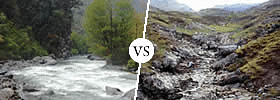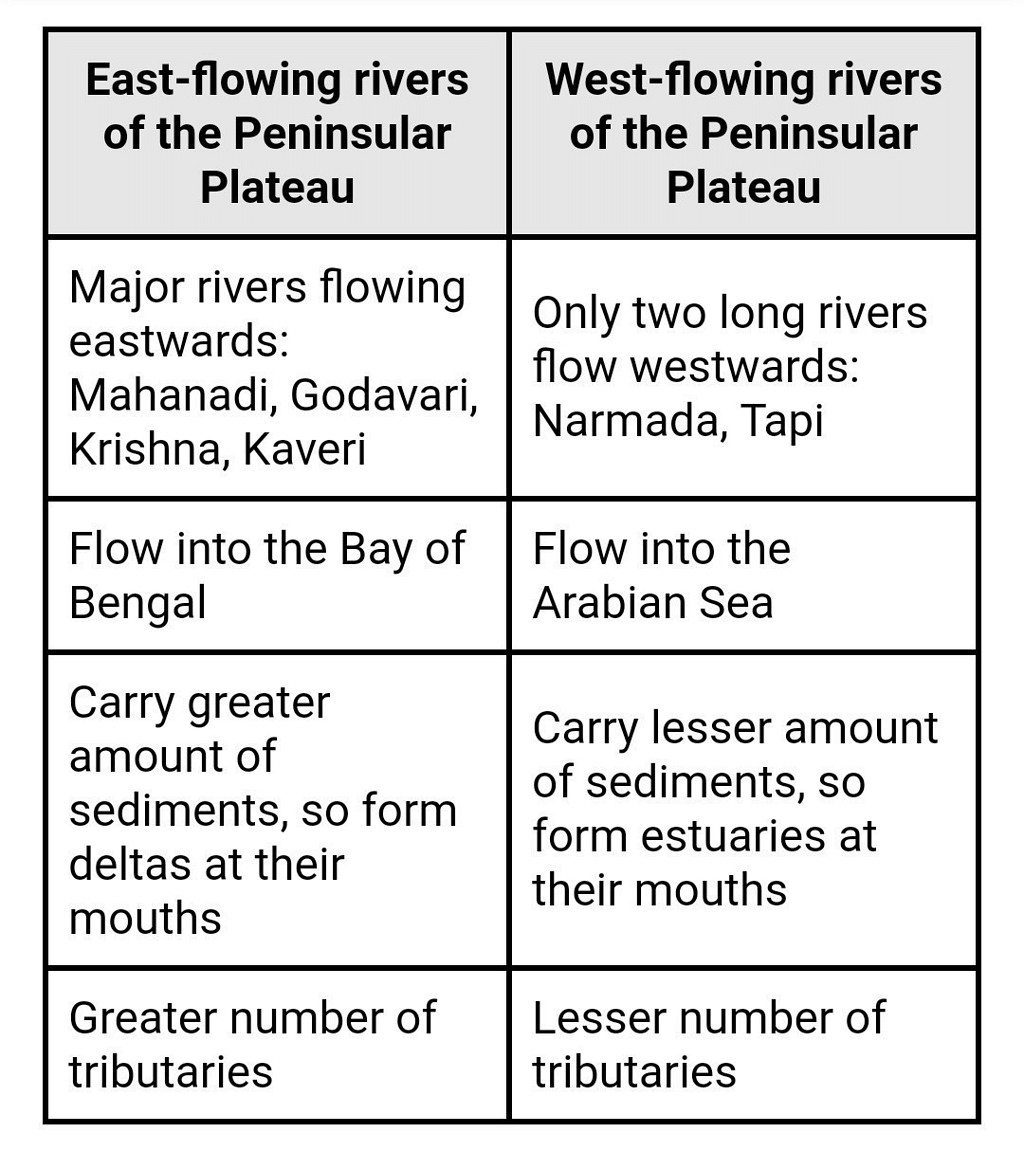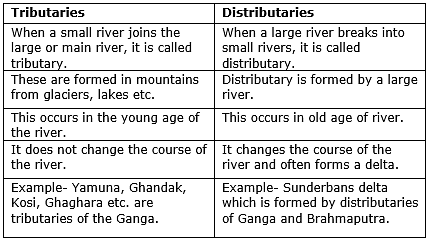Class 9 Geography Chapter 1 Question Answers - Contemporary India - I
Q1. What are perennial and non-perennial rivers? Give reasons why the Himalayan region consists of perennial rivers. (Important)
Perennial rivers flow throughout the year with an even flow, e.g., the Ganga. Non-perennial rivers are seasonal, flowing mainly during the rainy season, e.g., the Subarnarekha.
Himalayan rivers are perennial because they originate from snowfields and glaciers, ensuring a continuous water supply. During monsoons, heavy rainfall increases their flow, while in dry periods, melting snow and glaciers sustain them. Thus, these rivers flow year-round.
 Perennial vs Non-Perennial Rivers
Perennial vs Non-Perennial Rivers
Q2. Why is the Godavari often referred to as the 'Dakshin Ganga'? Write a note on the river Godavari and its tributaries. (Important)
The Godavari, the largest Peninsular river (1500 km), has the biggest drainage basin among Peninsular rivers, covering parts of Maharashtra, Madhya Pradesh, Odisha, and Andhra Pradesh. Due to its vast length and area, it is called the 'Dakshin Ganga'.
It originates from the Western Ghats in Nasik, Maharashtra, flows eastwards, and drains into the Bay of Bengal. Nearly half of its basin lies in Maharashtra. Major tributaries include the Wainganga, Penganga, Manjra, Purna, Wardha, and Pranhita.
 Godavari River
Godavari River
Q3. How are salt lakes formed? Give examples of salt lakes in India.
Salt lakes have high salt content and form in arid or semi-arid regions with inland drainage. They are often seasonal.
Formation:
- Wind action creates hollows reaching groundwater, forming shallow lakes that become salty due to evaporation.
- Short streams draining into desert basins can form temporary lakes with high salt due to rapid evaporation.
Example: The Sambhar Lake in Rajasthan, used for salt production.
Q4. What is a lagoon? How does it differ from a lake?
A lagoon is a stretch of brackish or saltwater separated from the sea by sandbanks, bars, or reefs, often found near river deltas (e.g., the Ganges, Mahanadi). Examples include Chilika Lake (Odisha), Pulicat Lake (Tamil Nadu), and Kolleru Lake (Andhra Pradesh).
Differences:
- Location: Lagoons form in coastal areas; lakes form anywhere (highlands, inland basins).
- Water Type: Lagoons have brackish water; lakes can have fresh or saltwater.
- Formation: Lagoons form from wind and wave action; lakes form through tectonics, rivers, glaciers, wind, or human activity.
Q5. What is a gorge? In what type of terrain does a gorge form?
A gorge is a steep-sided, narrow, I-shaped river valley found in the upper course of rivers in mountainous terrain. It forms due to the river's swift flow and vertical erosion as it descends steep slopes.
Gorges develop in areas with hard, resistant rocks, resulting in steep, nearly vertical valley sides. They are features of youthful topography and are common in recently uplifted regions like the Himalayas. Examples include the Indus Gorge and Brahmaputra Gorge.
Q6. What type of channel does the river Brahmaputra have? Write a short note on the formation of this type of channel.
The Brahmaputra has a braided channel throughout its course in Assam.
Formation:
- Heavy rainfall during monsoons increases water volume.
- Rapid erosion adds silt to the river, and when the load is excessive, silt is deposited in the riverbed.
- This causes the river to split into multiple shifting channels known as braided channels, creating islands between them.
Example: The Majuli Island, the world’s largest riverine island, has been eroded by floods.
Q7. Where are India’s most freshwater lakes located and why?
Most of India’s freshwater lakes are in the Himalayan region due to:
- Glacial activity: Glaciers form circular hollows (cirques), and melting snow creates freshwater lakes, e.g., Pangong Lake in Ladakh.
- Tectonic activity: Tectonic depressions filled with snowmelt form lakes like Wular Lake in Jammu and Kashmir, the largest freshwater lake in India.
Other important freshwater lakes include Dal Lake (Srinagar), Bhimtal and Nainital (Uttarakhand), Loktak Lake (Manipur), and Barapani Lake (Meghalaya).
Q8. What is a river basin? Explain briefly.
The area drained by a single river system, comprising a main river and its tributaries, is called its drainage basin or river basin. The term drainage describes the river system of an area. Small streams flowing from different directions come together to form the main river. It has number of tributaries and distributaries. The river ultimately drains into a large water body such as a lake or a sea or an ocean. The area drained by the main river, its tributaries and distributaries is termed as the river basin. The river Ganga has the largest river basin in India. The river Indus has a larger river basin but most of it lies outside India.
Q9. Write a note on the river Krishna and its tributaries.
The river Krishna rises from a spring near Mahabaleshwar. It flows eastwards to the Bay of Bengal. It has a length of about 1400 km, which makes it the second longest river of Peninsular India after Godavari which has a length of 1500 km. The Tungabhadra, the Koyna, the Bhima, the Ghatprabha and the Musi are important tributaries of the river Krishna. The drainage basin of the river Krishna lies in Maharashtra, Karnataka and Andhra Pradesh.
Q10. Name the three Himalayan river systems. Give two tributaries of each. (CBSE 2010)
Three Himalayan river systems are:
- The Indus river system
- The Ganga river system
- The Brahamaputra river system.
Tributaries:
- Indus river system – Satluj, Beas, Ravi
- Ganga river system – Yamuna, Ghaghara, Gandak
- Brahmaputra river system – Dibang, Lohit, Kenula.
Q11. Which of the factors mainly controls the drainage system of the Indian subcontinent? Into which major groups are the Indian rivers divided? Write three points of difference between the two.(CBSE 2010)
The drainage system of the Indian subcontinent are mainly controlled by the broad relief features. The Indian rivers are divided into two major groups:
- The Himalayan rivers and
- The Peninsular rivers.
Points of difference :
- The Himalayan rivers mostly originate in the Himalayan ranges whereas the Peninsular rivers mostly originate in the Western Ghats
- The Himalayan rivers are perennial whereas the Peninsular rivers are seasonal
- The Peninsular rivers have shorter and shallower courses in comparison to the Himalayan rivers.
Q12. Why are lakes of great value to human beings? Explain any three reasons.
(CBSE 2010)
Lakes are of great value to human beings.
- A lake helps to regulate the flow of a river. During heavy rainfall, it prevents flooding. During dry season, it helps to maintain an even flow of water.
- Lakes are also used for developing hydel power.
- Lakes help develop tourism and provide recreation.
Q13. Write any three features of the rivers originating in the Himalayas. (CBSE 2010)
Three main features of the Himalayan rivers are:
- Most of them are perennial.
- They have long and deep courses from their source to the sea.
- They perform intensive erosional activity in their upper courses and carry huge loads of silt and sand.
Q14. What is a lake? How are lakes formed? (CBSE 2010)
A lake is an area of water surrounded by land on all sides.
- There are lakes which are formed as a result of action of glaciers and ice sheets, while the others have been formed by wind, river action, and human activities.
- Some lakes are formed as a result of the tectonic activity. For example, Wular Lake in Jammu and Kashmir.
- The damming of rivers for the generation of hydel power has also led to the formation of lakes.
Q15. Which three river systems form the Himalayan river systems? [2010 (T-1)]
The Indus, Ganga and Brahmaputra have formed the three major Himalayan river systems of the country.
Q16. Describe any three important features of the river Brahmaputra. [2010 (T-1)]
The three important features of the river Brahmaputra are as follows:
- It passes through a high rainfall region and therefore carries a large volume of water and silt.
- It has braided channel in its entire length in Assam and forms many riverine islands.
- In rainy season, the river overflows it banks causing widespread floods in Assam and Bangladesh.
Q17. How does a river affect the economy of a country? [2010 (T-1)]
Water from the rivers is a basic natural resource. It is essential for various human activities. Therefore, river banks have attracted settlers of very ancient times. These settlements in course of time become cities. In India, rivers are used for irrigation, navigation and power generation besides agriculture. The agriculture is the major source of livelihood of the population and hence its role in the economy is a great.
Q18. What is the name of Brahmaputra in Tibet and Bangladesh? Give one feature of each. [2010 (T-1)]
Brahmaputra is known as the Tsangpo in Tibet and Jamuna in Bangladesh. One important feature of Brahmaputra in Tibet is that it carries a smaller volume of water and less silt as it passes through a cold and dry area in Tibat. In Bangladesh, however, in rainy season the river overflows its banks, carries much water and causeds widespread devastation by floods including siltation in the riverbed.
Q19. What are the differences between east-flowing and west-flowing rivers of the peninsular plateau? [2010 (T-1)]
The major rivers of the peninsular the the Mahanadi, the Godavari, the Krishna etc. are flowing eastward and merges into the Bay of Bengal. Only the river Narmada and Tapti are flowing towards west and merge into the Arabian Sea. The essential differences between the two rivers are as follows:
Q21. What are the causes of river pollution? Suggest some ways to overcome them? [2010 (T-1)]
The main cause of river pollution is the dumping of untreated sewage and industrial effluents into the rivers. This affects the quality of water.
Q20. What is the difference between the tributary and the distributary? Write any three points. [2010 (T-1)]
- A smaller stream joining with the mainstream is known as a tributary. A tributary is generally carried water and silt to the main river. River Jamuna is an example of a tributary of the river Ganga.
- A Distributary is formed at the lower coarse of the river when the main channel of the river gets blocked with silt which forced the river to open branches. The Bhagirathi-Hooghly is a distributary of the river Ganga. The main function of the distributary is to distribute water through newly opened channels.
The three basic differences between tributaries and distributaries are given below:
Q21. What are the causes of river pollution? Suggest some ways to overcome them? [2010 (T-1)]
The main cause of river pollution is the dumping of untreated sewage and industrial effluents into the rivers. This affects the quality of water.
- Recycling and reuse of wastewater are to be done to check wastewater.
- Wastewater is to be released after proper treatment.
- All outlets of effluents from industrial and domestic sources should be diverted to elsewhere.
Q22. Describe the three main features of the Narmada Basin. [2010 (T-1)]
The river Narmada emerges from the Amarkantak hills in Madhya Pradesh.
- It flows towards the west in a rift valley formed due to faulting.
- It creates many picturesque places like the Marble Rocks near Jabalpur and Dhuadhar Falls.
- All the tributaries of the Narmada are very short and most of them join at right angles to the mainstream.
|
53 videos|437 docs|80 tests
|
FAQs on Class 9 Geography Chapter 1 Question Answers - Contemporary India - I
| 1. What are the common types of drainage systems used in residential areas? |  |
| 2. How can I identify drainage problems in my yard? |  |
| 3. What are the benefits of having a proper drainage system? |  |
| 4. How can I improve drainage in my garden? |  |
| 5. What maintenance is required for drainage systems? |  |

|
Explore Courses for Class 9 exam
|

|




















